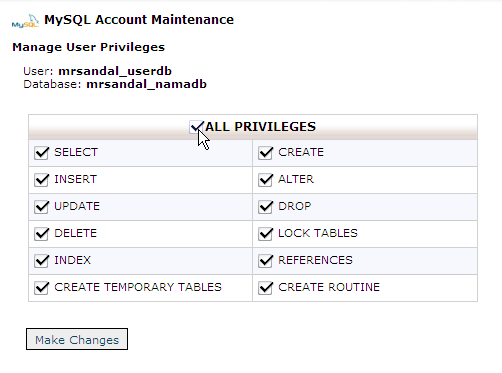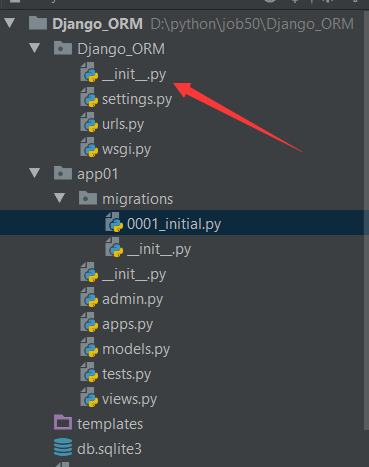

- #Mysql create user and grant access to database how to#
- #Mysql create user and grant access to database install#
- #Mysql create user and grant access to database update#
- #Mysql create user and grant access to database manual#
- #Mysql create user and grant access to database full#
This could be the common user that is configured during installation, or any other user with full privileges.

To follow along with this guide, we will assume that you are using an account with full administrative privileges (including the GRANT OPTION privilege).
SELECT on mysql.*: used to execute SHOW GRANTS for other accounts. whatever privileges you wish to assign to other users. GRANT OPTION: the GRANT OPTION privilege allows you to grant or revoke any privilege that you have been granted. To manage privileges for MySQL users, you need to have the following privileges: REVOKE: use to remove existing privileges from a user account. GRANT: use to assign new privileges to a user account. The most important commands we'll be using in this guide are the GRANT and REVOKE commands: To follow along with this guide, you'll need an account on a MySQL server with the appropriate privileges. #Mysql create user and grant access to database how to#
In this guide, we will talk about how to use the GRANT and REVOKE commands to add and remove privileges from MySQL user accounts and implement access policies that match your requirements. MySQL has a robust privilege assignment system that allows you to implement access policies throughout your database system. Deciding who should have what access to which components and powers and then designing an implementation that enables those policies requires a good deal of thought and care. Privilege management is an important part of system and database administration.
The United States' most popular databases by state going into 2022. Traditional databases vs serverless databases. Introduction to common serverless challenges. Top 13 serverless computing and database providers. Introduction to database backup considerations. How microservices and monoliths impact the database. Syncing development databases between team members. Troubleshooting database outages and connection issues. What is connection pooling and how does it work?. Top 8 TypeScript ORMs, query builders, & database libraries: evaluating type safety. Top 11 Node.js ORMs, query builders & database libraries in 2022. Introduction to MongoDB Aggregation Framework. Introduction to MongoDB database tools & utilities. Working with dates and times in MongoDB. Introduction to MongoDB connection URIs. How to query and filter documents in MongoDB. How to manage databases and collections in MongoDB. How to manage authorization and privileges in MongoDB. How to manage users and authentication in MongoDB. Introduction to provisioning MongoDB Atlas. How to export database and table schemas in SQLite. #Mysql create user and grant access to database update#
How to update existing data with SQLite.  How to perform basic queries with `SELECT` with SQLite. Inserting and deleting data with SQLite. Creating and deleting databases and tables with SQLite. An introduction to MySQL column and table constraints. How to create and delete databases and tables in MySQL. How to manage privileges with roles in MySQL. How to use `GRANT` and `REVOKE` to manage privileges in MySQL. How to manage users and authentication in MySQL. An introduction to authorization and authentication in MySQL. An introduction to PostgreSQL column and table constraints. An introduction to PostgreSQL data types.
How to perform basic queries with `SELECT` with SQLite. Inserting and deleting data with SQLite. Creating and deleting databases and tables with SQLite. An introduction to MySQL column and table constraints. How to create and delete databases and tables in MySQL. How to manage privileges with roles in MySQL. How to use `GRANT` and `REVOKE` to manage privileges in MySQL. How to manage users and authentication in MySQL. An introduction to authorization and authentication in MySQL. An introduction to PostgreSQL column and table constraints. An introduction to PostgreSQL data types.  How to create and delete databases and tables in PostgreSQL. Managing privileges in PostgreSQL with grant and revoke. Configuring PostgreSQL user authentication. Managing roles and role attributes in PostgreSQL. An introduction to authorization and authentication in PostgreSQL. How to configure a PostgreSQL database on RDS. Comparing relational and document databases. Glossary of common database terminology. Comparing database types: how database types evolved to meet different needs. Then after searching I tried this command as well - GRANT ALL PRIVILEGES ON *.* TO IDENTIFIED BY 'root' and gotĮrror - ERROR 1410 (42000): You are not allowed to create a user with GRANT I tried almost every syntax by changing the to tried removing and adding the APOSTROPHE on 'root' in IDENTIFIED BY 'root',
How to create and delete databases and tables in PostgreSQL. Managing privileges in PostgreSQL with grant and revoke. Configuring PostgreSQL user authentication. Managing roles and role attributes in PostgreSQL. An introduction to authorization and authentication in PostgreSQL. How to configure a PostgreSQL database on RDS. Comparing relational and document databases. Glossary of common database terminology. Comparing database types: how database types evolved to meet different needs. Then after searching I tried this command as well - GRANT ALL PRIVILEGES ON *.* TO IDENTIFIED BY 'root' and gotĮrror - ERROR 1410 (42000): You are not allowed to create a user with GRANT I tried almost every syntax by changing the to tried removing and adding the APOSTROPHE on 'root' in IDENTIFIED BY 'root', #Mysql create user and grant access to database manual#
When I run this command,I get the error- GRANT SELECT,INSERT,UPDATE,DELETE,CREATE,DROP,ALTERĮRROR 1064 (42000): You have an error in your SQL syntax check the manual that corresponds to your MySQL server version for the right syntax to use near 'IDENTIFIED BY 'root'' at line 1
#Mysql create user and grant access to database install#
I was trying to install wordpress on ubuntu using the link and struck at








 0 kommentar(er)
0 kommentar(er)
